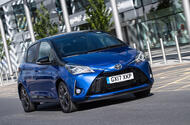
The third-gen Yaris was ahead of its time thanks to hybrid technology – but does it still appeal as a used buy?
It cuts a fairly sedate and predictable figure today, but the humble-looking third-generation Toyota Yaris was a good way ahead of its time when it was launched in 2011, combining innovative, wallet-busting hybrid technology with a tiny footprint, a surprisingly spacious interior and the Japanese manufacturer’s trademark unwavering dependability.Factor in a five-star safety rating, a wide range of well-equipped and clearly defined trim packages and used prices as low as £2000 and it’s hard to find a reason not to recommend it to a 17-year- old as their first set of wheels – or anyone in need of frugal, fuss-free motoring. Building on the almighty success of the Prius, Toyota saw an opportunity to install its hybrid technology in a smaller model – and it claimed to be the first to offer such a powertrain in this segment (although Honda had technically got there just before with the Jazz). Costing just under £17,000 when new, the Yaris Hybrid was pretty good value at the time, although its efficiency-biased 98bhp powertrain – based around a naturally aspirated 1.5-litre four-cylinder petrol engine – was roundly outpaced by zippier pure-petrol rivals and the exclusive use of a CVT meant it was pretty noisy at higher revs too.The trade-off was an eye-catching 75mpg combined, Toyota claimed. Impressive, even if the read-out was nearer 50mpg in the real world.There was also the option of two pure-petrol engines – a 68bhp 1.0-litre and a 98bhp 1.3-litre – as well as an 89bhp 1.4-litre diesel. The pokier petrol is our pick of the range. Its five-speed manual gearbox is easier to get along with than the frustrating CVT and its efficiency isn’t far off that of its electrically aided range-mate. The Yaris doesn’t handle quite as well as the contemporary Ford Fiesta or Volkswagen Polo, not helped by its lighter steering, and unkempt rural roads highlight a rougher edge to its dynamics, with the suspension struck dumb by bad potholes and bumps. Still, its comfortable seats and smart cabin help to make it a compelling alternative.Even the hybrid version, with its batteries sited under the back seats, has plenty of rear space, which is one reason why it’s often found these days loaded with sixth-formers on their way to grab a meal deal. The basic entry-level car, badged T2, doesn’t have enough kit to make it an attractive used buy.You will want at least a T4. The TR has enough equipment to feel like a relatively new car, including a touchscreen, electric mirrors and a reversing camera. The SR and T-Spirit range-toppers add the likes of sat-nav and dual-zone climate control. The trims were renamed as part of a restyle in 2014, with Active at the base and Icon, Sport and Excel swelling the kit roster. The Yaris was updated again in 2017 to keep pace with Ford and Volkswagen, with a light restyling and the 1.3-litre petrol swapped for a more efficient 1.5-litre.There was also the option of two-tone paint, updated infotainment and swisher materials for the range-topper. Whether you’re buying one as a first car or for short trips around town, the Yaris is a dependable supermini that is reasonably practical and affordable.Seek out a post-2014 car with the 1.3-litre petrol manual powertrain to get the smarter looks, more spritely performance and the tech and refinement to match many a newer alternative.
Source: Autocar